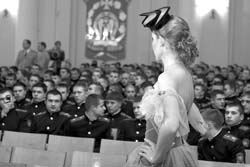“The star will rise, freedom will come”
Singer Oleh Skrypka sets an example of how to popularize history
On Feb. 22 the Ivan Bohun Military Lyceum of Kyiv hosted a major cultural event: the popular Ukrainian band Vopli Vidopliasova, VV for short, presented its musical video Kateryna , based on events connected with the liberation struggle during the period of the Ukrainian National Republic (UNR). This is arguably the first notable attempt to create a historical reconstruction of those times. The events reproduced in the video took place between September 1919 and January 1920, when the First Mounted Regiment of Black Zaporozhian Cossacks, or chornoshlychnyky — black hats, one of the most legendary units of the Ukrainian Army, fought against the troops of General Denikin. The Black Zaporozhian Cossacks in the video are played by the musicians from VV, and the White Guard troops by members of the Kyiv Military-Historical Club. The video also incorporates popular motifs of Ukrainian folklore and art, which have become canonical: a young woman seeing her lover off to war, a mother blessing her son, a soldier falling off his horse, a horse standing over a dead Cossack.
Besides the main characters, other musicians had a hand in making the video: violin virtuoso Serhiy Okhrimchuk, Serhiy Postolnykov from the group Huliayhorod, kobza player Viktor Kompanychenko and his father Taras, and Oleh Skrypka’s wife Natalka Syd. “I believe that this composition shows a harmonious blend of heroism with elements of burlesque,” says Kompanychenko, who was one of the consultants to the camera crew. “This combination is especially typical of the songs of the Sich Riflemen [Sichovi Striltsi]. Unfortunately, few people are aware of this because Ukrainian radio stations mostly play the songs of the White Guard, especially the well-known [Russian] song ‘Keep your head up, Lieutenant Golitsyn.’ Meanwhile, there is a huge stratum of Ukrainian military songs that for some reason have remained outside our reality.”
Skrypka, who wrote the script for Kateryna, also consulted the historian Yaroslav Tynchenko. As a result, the costumes of the main characters closely match the uniform of the Black Cossacks: black and red peaked hats with silver tassles, long tunic-style coats, and traditional pantaloons (sharovary) made of thick cloth. Incidentally, the original uniforms of several regiments of the UNR army are on display only in one Lviv museum.
Oleh has a tireless imagination. This time he and his musicians put on the uniforms and arrived at the screening on horseback, which added a special touch to the event. Most importantly, before the premiere the audience saw a display on a wide screen of unique documentary photos of Symon Petliura, the generals Bezruchko and Hanziuk, Colonel Bolbachan, and Ensign Shandruk with captions reading “died a hero’s death,” “executed by firing squad,” or “died in exile.” I immediately recalled my visit to the grave of Symon Petliura in Paris. Many people in the audience were seeing these heroes for the first time. Meanwhile, as Ukrainian archetypes, these individuals comprised the masculine foundation that we now lack.
Kompanychenko, who possesses unique knowledge and abilities, performed lyrical Sich Riflemen songs to the accompaniment of the bandura. When he scolded some of the lyceum students, who were obviously unprepared for this subject, we saw another Taras — fiery and intolerant of ignorance.
Oleh took the floor after the screening of Kateryna: “In 1992, when I wrote this song, which started with the words, ‘The star will rise, freedom will come,’ I didn’t know anything about the UNR. I may have heard something about Symon Petliura, but this information came from Soviet sources. At the time I sensed intuitively that there were Ukrainian melodies in Soviet military songs. Later Taras told me about the transformation of our songs into Soviet ones, providing many examples, in particular ‘Oh, the Red (instead of Sichovi) Striltsi going into battle.’ After our talks I got the idea to shoot a historical video. With this video we would like to stress once again that we are not engaged in show business; we belong to the modern cultural process and hope that this work creates a cultural resonance.”
This is definitely a precedent. Vopli Vidopliasova is lifting the curtain on a little-known historical stratum. The history of the UNR has heroic pages — the battle of Kruty — tragic ones — the defeat near Bazar — and victorious episodes — the Act of Unification of the UNR and the Western Ukrainian National Republic (ZUNR). Others should follow VV’s example and interpret them.
“VV has not simply produced a video as an advertisement for their song. They have set an example of how to popularize history,” musical commentator Yurko Zelenyi sums up. “After all, we do not have a single blockbuster on the struggle of the OUN and UPA, for example. Judging by the publicity created by this screening, this is the best possible way for bringing the truth about our victories to the younger generation. Moreover, the very screening of the video was somewhat provocative. Everything was done using commercial methods, but not for the sake of profit. The fact that Oleh Skrypka is collaborating creatively with Taras Kompanychenko and the band Huliayhorod and shares common ideas with Foma and Sashko Polozhynsky is evidence of a phenomenon that can be characterized by the folk proverb: ‘sviy do svoho po svoye’ [like mind going to like mind for what is common to both]. This community of like-minded people, which will obviously expand, is influencing and even correcting distortions in our informational space, which our politicians are unable to put right.”






